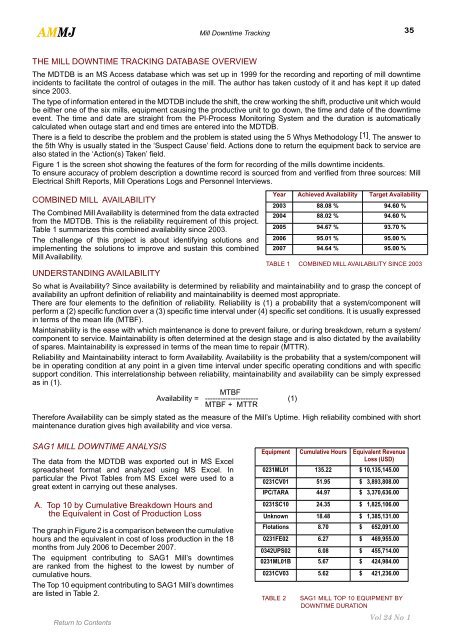AMMJ - Library
AMMJ - Library
AMMJ - Library
You also want an ePaper? Increase the reach of your titles
YUMPU automatically turns print PDFs into web optimized ePapers that Google loves.
<strong>AMMJ</strong> Mill Downtime Tracking 35<br />
THE MILL DOWNTIME TRACKING DATABASE OVERVIEW<br />
The MDTDB is an MS Access database which was set up in 1999 for the recording and reporting of mill downtime<br />
incidents to facilitate the control of outages in the mill. The author has taken custody of it and has kept it up dated<br />
since 2003.<br />
The type of information entered in the MDTDB include the shift, the crew working the shift, productive unit which would<br />
be either one of the six mills, equipment causing the productive unit to go down, the time and date of the downtime<br />
event. The time and date are straight from the PI-Process Monitoring System and the duration is automatically<br />
calculated when outage start and end times are entered into the MDTDB.<br />
There is a field to describe the problem and the problem is stated using the 5 Whys Methodology [1] . The answer to<br />
the 5th Why is usually stated in the ‘Suspect Cause’ field. Actions done to return the equipment back to service are<br />
also stated in the ‘Action(s) Taken’ field.<br />
Figure 1 is the screen shot showing the features of the form for recording of the mills downtime incidents.<br />
To ensure accuracy of problem description a downtime record is sourced from and verified from three sources: Mill<br />
Electrical Shift Reports, Mill Operations Logs and Personnel Interviews.<br />
COMBINED MILL AVAILABILITY<br />
The Combined Mill Availability is determined from the data extracted<br />
from the MDTDB. This is the reliability requirement of this project.<br />
Table 1 summarizes this combined availability since 2003.<br />
The challenge of this project is about identifying solutions and<br />
implementing the solutions to improve and sustain this combined<br />
Mill Availability.<br />
UNDERSTANDING AVAILABILITY<br />
So what is Availability? Since availability is determined by reliability and maintainability and to grasp the concept of<br />
availability an upfront definition of reliability and maintainability is deemed most appropriate.<br />
There are four elements to the definition of reliability. Reliability is (1) a probability that a system/component will<br />
perform a (2) specific function over a (3) specific time interval under (4) specific set conditions. It is usually expressed<br />
in terms of the mean life (MTBF).<br />
Maintainability is the ease with which maintenance is done to prevent failure, or during breakdown, return a system/<br />
component to service. Maintainability is often determined at the design stage and is also dictated by the availability<br />
of spares. Maintainability is expressed in terms of the mean time to repair (MTTR).<br />
Reliability and Maintainability interact to form Availability. Availability is the probability that a system/component will<br />
be in operating condition at any point in a given time interval under specific operating conditions and with specific<br />
support condition. This interrelationship between reliability, maintainability and availability can be simply expressed<br />
as in (1).<br />
MTBF<br />
Availability = --------------------- (1)<br />
MTBF + MTTR<br />
Therefore Availability can be simply stated as the measure of the Mill’s Uptime. High reliability combined with short<br />
maintenance duration gives high availability and vice versa.<br />
SAG1 MILL DOWNTIME ANALYSIS<br />
The data from the MDTDB was exported out in MS Excel<br />
spreadsheet format and analyzed using MS Excel. In<br />
particular the Pivot Tables from MS Excel were used to a<br />
great extent in carrying out these analyses.<br />
A. Top 10 by Cumulative Breakdown Hours and<br />
the Equivalent in Cost of Production Loss<br />
The graph in Figure 2 is a comparison between the cumulative<br />
hours and the equivalent in cost of loss production in the 18<br />
months from July 2006 to December 2007.<br />
The equipment contributing to SAG1 Mill’s downtimes<br />
are ranked from the highest to the lowest by number of<br />
cumulative hours.<br />
The Top 10 equipment contributing to SAG1 Mill’s downtimes<br />
are listed in Table 2.<br />
Year Achieved Availability Target Availability<br />
2003 88.08 % 94.60 %<br />
2004 88.02 % 94.60 %<br />
2005 94.67 % 93.70 %<br />
2006 95.01 % 95.00 %<br />
2007 94.64 % 95.00 %<br />
TABLE 1 COMBINED MILL AVAILABILITY SINCE 2003<br />
Equipment Cumulative Hours Equivalent Revenue<br />
Loss (USD)<br />
0231ML01 135.22 $ 10,135,145.00<br />
0231CV01 51.95 $ 3,893,808.00<br />
IPC/TARA 44.97 $ 3,370,636.00<br />
0231SC10 24.35 $ 1,825,106.00<br />
Unknown 18.48 $ 1,385,131.00<br />
Flotations 8.70 $ 652,091.00<br />
0231FE02 6.27 $ 469,955.00<br />
0342UPS02 6.08 $ 455,714.00<br />
0231ML01B 5.67 $ 424,984.00<br />
0231CV03 5.62 $ 421,236.00<br />
TABLE 2 SAG1 MILL TOP 10 EQUIPMENT BY<br />
DOWNTIME DURATION<br />
Vol 24 No 1

















